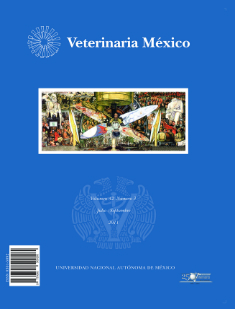Prevalence of Giardia intestinalis and zoonotic genotype predominance in small scale sheep and cattle farms in five states of the Mexican Republic
Main Article Content
Abstract
The aim of this paper was to discover the prevalence and assemblages of Giardia intestinalis, harbored in sheep and cows on familiar farms from five states of the Mexican Republic. Stool samples from 265 sheep and 174 cows were analyzed by centrifugation and flotation in zinc sulfate to search for cysts and ova. The samples with Giardia cysts were processed in a Sheather solution in order to isolate them. Afterwards, cultures were established in TYI-S-33, each one of which was the Giardia DNA source. The DNA was obtained and used as a template to amplify a fragment of the glutamate dehydrogenase (gdh) enzyme. The 430 bp amplicons were restricted with Nla IV and Rsa I in order to identify the restriction fragments length polymorphisms (RFLP´s) patterns. From the cyst analysis, Giardia cysts in nine cows (5.1%) and 30 sheep (11.3%) were found. Then 10 axenic cultures (5 from sheep and 5 from cows) were set up. From the RFLP´s pattern it was found that one cow had assemblage (AI), another two had a mixture of assemblages (AI + BIII) and the other two had (E + BIII). In sheep, it was found that two sheep had assemblage (AI) and the other three had a mixture of assemblages (AI + BIII). This is the first report in which zoonotic assemblages (A-I and BIII) predominance in ruminants from five states of Mexico have been demonstrated. Therefore, it is necessary to carry out further studies aimed at discovering other Giardia genotypes and transmission patterns between animals and humans in Mexico.
Keywords:
Giardia intestinalis zoonotic genotypes glutamate dehydrogenase sheep cattle
Article Details
License

Veterinaria México OA by Facultad de Medicina Veterinaria y Zootecnia - Universidad Nacional Autónoma de México is licensed under a Creative Commons Attribution 4.0 International Licence.
Based on a work at http://www.revistas.unam.mx
- All articles in Veterinaria México OA re published under the Creative Commons Attribution 4.0 Unported (CC-BY 4.0). With this license, authors retain copyright but allow any user to share, copy, distribute, transmit, adapt and make commercial use of the work, without needing to provide additional permission as long as appropriate attribution is made to the original author or source.
- By using this license, all Veterinaria México OAarticles meet or exceed all funder and institutional requirements for being considered Open Access.
- Authors cannot use copyrighted material within their article unless that material has also been made available under a similarly liberal license.



